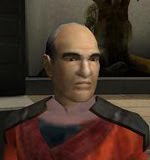You're on a game show in Cloud City, and host Lando Calrissian is giving you a chance to win one of the starships in his lot on Nar Shaddaa. There are three closed doors on stage. Lando explains that behind one of them is his marker for one of his starships, while behind each of the other two doors is a womp rat. Whichever door you choose to open, you win the prize behind it. Lando asks you to choose one of the three doors. You do. But before you open that door, Lando says he'll help you out by opening one of the two OTHER doors. He opens one, revealing a womp rat. (He knows what lies behind each door, so he will always choose to reveal a womp rat; if both of the OTHER doors have womp rats, he will choose one to open at random.) He now gives you a choice: Do you want to open the door you originally chose--the SELECTED door--or switch to the other closed door--the REMAINING door?
Maybe you're very attached to the door you chose at the beginning, but ultimately the question is, What is your chance of winning if you stick with the SELECTED door, and what is your chance of winning if you switch to the REMAINING door? Take some time to think about it.

The intuitive answer is that it's 50-50 either way. There are two closed doors at this point. One has the ship, one has the second womp rat, so there is clearly a 50% chance the starship voucher is behind either door. Right? Wrong (you saw that coming). In fact, you have a 1/3 chance of winning the ship if you stick to the SELECTED door but a 2/3 chance of winning the ship if you switch to the REMAINING door. Switching doubles your chances of winning, so that is the better bet to make.
What I love about the problem is how easy it is to be fooled by this question. It blew my mind the first time I learned it. When the question was presented and correctly answered in Parade magazine's Ask Marilyn column in 1990, about 10,000 readers including, apparently, nearly 1000 with PhDs wrote in arguing that her solution was wrong--that there was a 50-50 chance and thus no advantage to switching. There was some ambiguity in the phrasing of the problem as presented in the magazine (basically the details that I put in parentheses were left out), which would affect the answer. But most people assume those details, anyway, and barely any of her critics noted that ambiguity. She defended her answer, and others jumped in to defend her as well (NYT article). They prevailed: the better choice is to switch.
Here's what I think is the easiest way to understand the solution. There are two situations that you can find yourself in:
- Your SELECTED door has the starship voucher behind it. If that happens, Lando will open one of the two womp rat doors. Keeping the SELECTED door wins you the ship, while switching to the REMAINING door gives you a womp rat.
- Your SELECTED door has a womp rat behind it. If that happens, Lando will open the other door with a womp rat. Keeping the SELECTED door gives you a womp rat, while switching to the REMAINING door wins you the starship.
Want an explanation that doesn't involve counting up possible outcomes? When you choose the door at the beginning, there is a 1/3 chance that the ship voucher is behind that SELECTED door. The two OTHER doors together have a 2/3 chance of having the starship. But Lando makes sure that you can only open one of those two OTHER doors (you can't open the one he's already opened to reveal a womp rat). Thus, if the ship voucher was behind either of those two doors (2/3 chance of this), it will be behind the REMAINING door. This means that there is a 2/3 chance that the starship voucher is behind the REMAINING door.
Pretty cool, right? I'm telling you, people at parties love this stuff. Well, particularly if they're nerds.
Further analysis, explanations, and variations of this problem can be found on the Monty Hall Problem Wikipedia page.
















2 comments:
This is definitely one of my favorite math problems because it just doesn't seem like it should work, until you prove that it does.
Exactly! It just feels wrong when you first learn it. Math is fun :)
Post a Comment